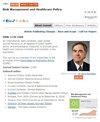How Does Psychological Distance Influence Public Risky Behavior During Public Health Emergencies
IF 2
4区 医学
Q2 HEALTH CARE SCIENCES & SERVICES
引用次数: 0
Abstract
Background: Public health emergencies not only threaten the physical and mental health of the public but also trigger a series of risky behaviors of the public, which in turn lead to the emergence or intensification of risk events, disrupting existing economic and social order.Purpose: Based on construal level theory, cognitive appraisal theory of emotions and mood maintenance hypothesis, the study aims to investigate the collectively effect of risk perception and psychological insecurity in the connection between psychological distance and public risky behavior.
Participants and Methods: Cross-sectional data was derived from 257 China urban residents. All participants finished the psychological distance scale, risk perception scale, psychological insecurity scale, and risky behavior scale. The research hypothesis was tested using the PROCESS macro.
Results: The direct impact of psychological distance on risky behavior was not significant (β=− 0.018, p> 0.05). The indirect impact of psychological distance on risky behavior was significant. In other words, the impact of psychological distance on risky behavior was serially mediated via risk perception and psychological insecurity (β=0.011, 95% CI= [0.0013, 0.025]).
Conclusion: Risk perception and psychological insecurity play serial mediating roles in the relationship between psychological distance and public risky behavior. We conclude that during public health emergencies, public health managers should pay extra attention to the risk perception and psychological insecurity level of the public with closer psychological distance, take measures to reduce their risk perception, enhance their psychological security, and reduce their risky behavior, thereby ensuring the physical and mental health of the public and maintaining the stability of economic and social order.
心理距离如何影响公众在突发公共卫生事件中的风险行为
背景:目的:本研究基于构念水平理论、情绪认知评价理论和情绪维持假说,探讨风险认知和心理不安全感在心理距离与公众风险行为联系中的共同作用:横断面数据来自 257 名中国城市居民。所有参与者均完成了心理距离量表、风险认知量表、心理不安全感量表和风险行为量表。研究假设采用 PROCESS 宏进行检验:心理距离对风险行为的直接影响不显著(β=- 0.018,p> 0.05)。心理距离对风险行为的间接影响显著。换句话说,心理距离对风险行为的影响是通过风险认知和心理不安全感串联起来的(β=0.011, 95% CI= [0.0013, 0.025]):风险认知和心理不安全感在心理距离与公共风险行为之间的关系中起着连续的中介作用。我们认为,在突发公共卫生事件中,公共卫生管理者应格外关注心理距离较近的公众的风险感知和心理不安全感水平,采取措施降低其风险感知,增强其心理安全感,减少其危险行为,从而保障公众的身心健康,维护经济和社会秩序的稳定。
本文章由计算机程序翻译,如有差异,请以英文原文为准。
求助全文
约1分钟内获得全文
求助全文
来源期刊

Risk Management and Healthcare Policy
Medicine-Public Health, Environmental and Occupational Health
CiteScore
6.20
自引率
2.90%
发文量
242
审稿时长
16 weeks
期刊介绍:
Risk Management and Healthcare Policy is an international, peer-reviewed, open access journal focusing on all aspects of public health, policy and preventative measures to promote good health and improve morbidity and mortality in the population. Specific topics covered in the journal include:
Public and community health
Policy and law
Preventative and predictive healthcare
Risk and hazard management
Epidemiology, detection and screening
Lifestyle and diet modification
Vaccination and disease transmission/modification programs
Health and safety and occupational health
Healthcare services provision
Health literacy and education
Advertising and promotion of health issues
Health economic evaluations and resource management
Risk Management and Healthcare Policy focuses on human interventional and observational research. The journal welcomes submitted papers covering original research, clinical and epidemiological studies, reviews and evaluations, guidelines, expert opinion and commentary, and extended reports. Case reports will only be considered if they make a valuable and original contribution to the literature. The journal does not accept study protocols, animal-based or cell line-based studies.
 求助内容:
求助内容: 应助结果提醒方式:
应助结果提醒方式:


